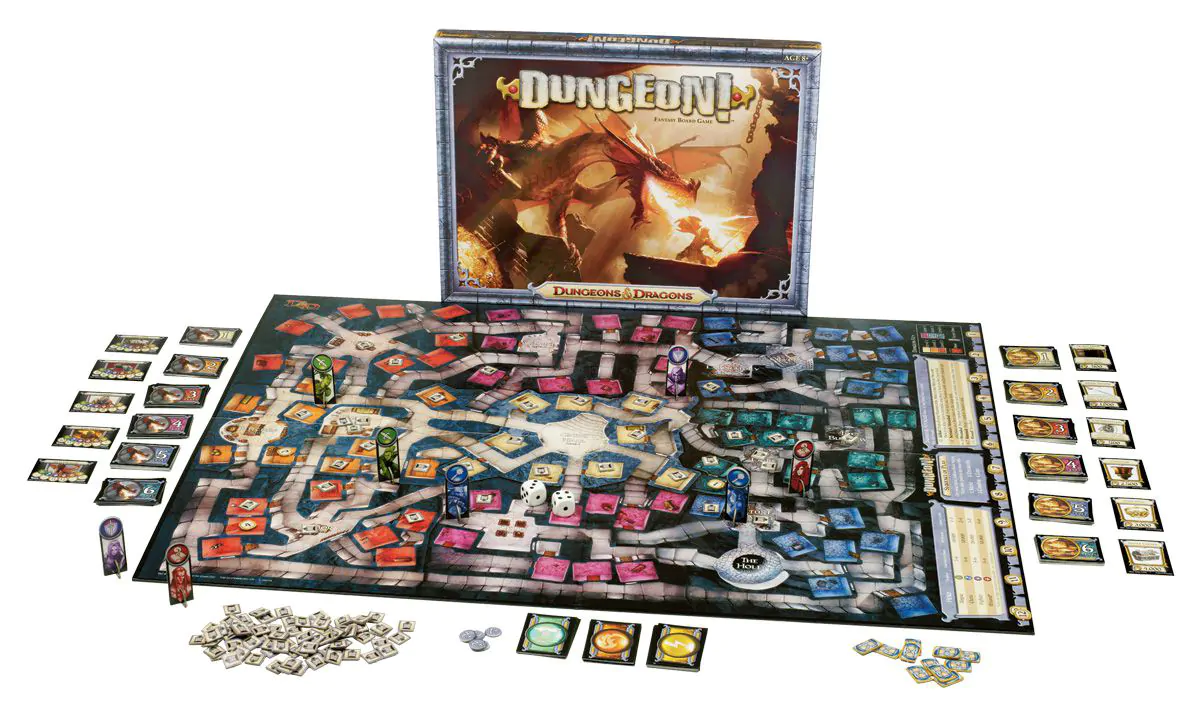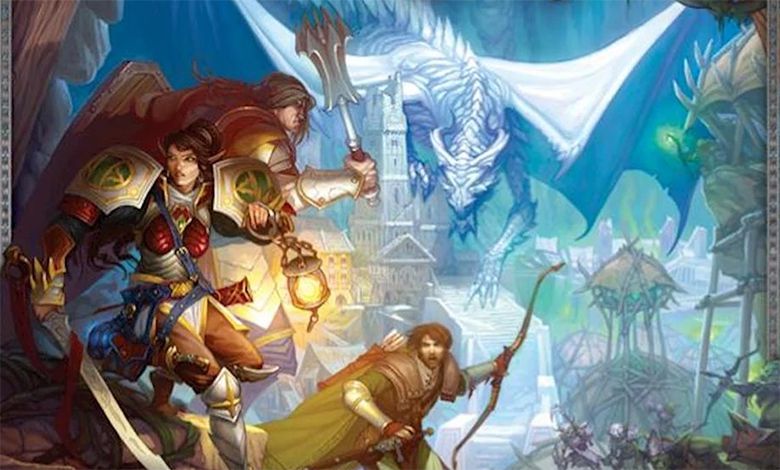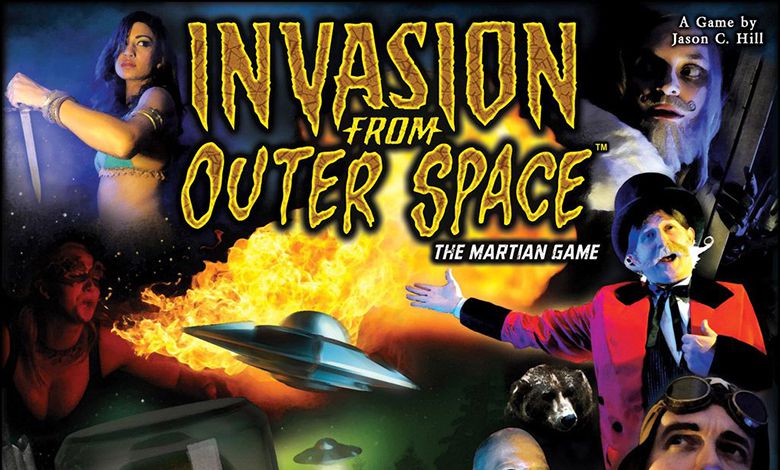
Publisher: Don Gusano Games
Designer: An M.D.
Artist: Len Peralta
Year: 2010
Players: Two to six players
Ages: 13+
Playing Time: 45 Minutes
Genre: Card game of medical malpractice
MSRP: $19.95
Here’s an interesting little card game. Its got a theme I haven’t seen used before. In Quack in the Box, each player is a doctor who treats patients and attempts to cure them. If you manage it, then you get to collect the cash and have the satisfaction of a job well done. If they leave in a body bag, which happens more often than not, then you can expect to be lynched by an angry mob.
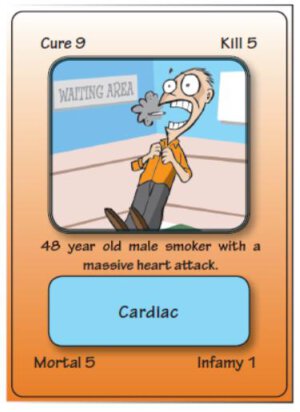
To play Quack in the Box you are going to need a die, score sheet, and pencil. These don’t come with the game, but most of us have them lying about in abundance. Separate the cards into two piles, the patient deck and the doctor deck (all cards not in the patient deck). As to the cards themselves, they have decent artwork, and are just a bit thinner than a regular playing card.
Each player gets six cards from the doctor deck, and you are set to play. The game turn is separated into six phases.
In phase one you may choose to flee the country to Switzerland if you wish. The mechanic governing this decision is your infamy score. At the start of the game, the players all agree on an infamy score maximum. As you accidentally kill patients, your infamy score rises. Once it reaches the agreed upon maximum, you are out and the mob lynches you. So if the maximum is ten infamy and you are sitting at eight, you might want to head for the hills. The rules suggest using six as the max for a short game and twelve for a longer one.
In phase two you draw from the deck until you have six cards.
In phase three you draw a patient if you don’t already have one and play it in front of you. A patient card has several stats that are important. The cure value lets you know how many cure points it will take to cure the patient. Under the artwork is a sentence listing the patients complaint, and under that is a box listing the treatments that the patient needs to recover. There is also a kill score. If your treatments do more harm than good and you exceed the kill score, the patient dies and their infamy score is added to yours. Some patients also have a Mortal score. If you play cards numbering more than the mortal score, that also kills the patient (too many treatments), and again you gain the patient’s infamy score.
During phase four the player rolls a die, looking for a number between 2 and 5 (if you roll a 1 or 6 just reroll), and during phase five you must play that number of treatment cards on your patient this turn, even if it hurts the patient. Treatment cards are the cards in your hand, they list a cost, or amount of money you earn if you cure the 
So you play your cards and hope you have the ones that will cure them. If you do, you earn all of the money listed on all of the treatments played. If you kill them, you earn the infamy instead. If you don’t have enough treatment cards, you can play what you have and discard or play an anytime card. The patient, if not cured or killed, holds on until your next turn and you will treat them again.
The other cards that make up your hand are the anytime cards. These can be played at, well, any time. They do things like cure a patient automatically; change the symptoms on an opponent’s patient, and other good and bad things.
Phase six is the angry mob phase. If your infamy score has reached the maximum, you lose and are out of the game.
When you are down to only two active players left (I’m not sure what you do if you are playing with only two players), then you each take one more turn, then the game is over. Each surviving player totals up their money earned and the highest total wins.
There are good points and bad points to the game. First of all, we all hated having to play bad treatments on the patients. It became annoying. More often than not you have no choice and you end up killing three out of four patients. Secondly, there is mostly luck in this game with little strategy. It all depends on the draw of the cards and the roll of the die. Thirdly, the rules are very short and a bit unclear. How do you play with two players? The “All Others” category of treatment isn’t well explained, if you successfully treat a symptom with a card, can it also 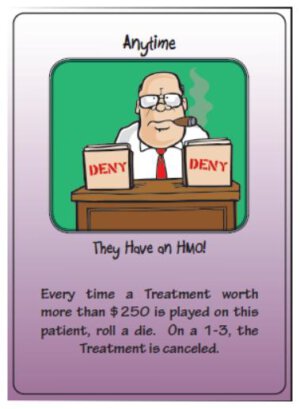
The nice thing about the game is that it is pretty interesting. You learn the actual treatments for various conditions, and what different common medications treat. Let me point out that the rules state “For the love of all that is good, please don’t use any of the information from this game to treat yourself”, and that is good advice, but it is still pretty interesting. I liked treating patients and trying to cure them. I just wish I wasn’t forced to kill so many.
In the end, it is an interesting game and I like the theme. Keeping track of infamy and money was a bit of a pain, and I don’t like rolling the die to be forced to treat the patient a certain number of times. The kids didn’t like it, the adults liked it more, but again it was annoying to be forced to kill so many patients. A few rules clarifications and some manipulation of the mechanics and this game would be a big hit. I did find the premise pretty entertaining.
[rwp-review id=”0″]
- A Dungeon Delve for Kids?: A Review of Dungeon! - Oct 24, 2022
- Better, Stronger, Faster | Descent: Journeys in the Dark Second Edition Reviewed - Oct 23, 2022
- Your Planet is Doomed!: Invasion from Outer Space Reviewed - Oct 22, 2022


